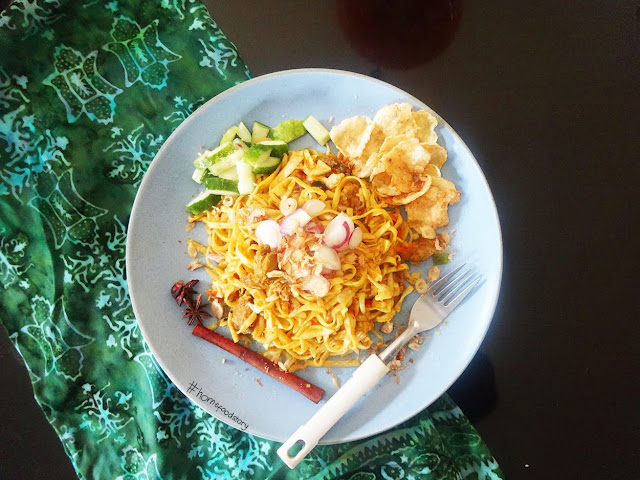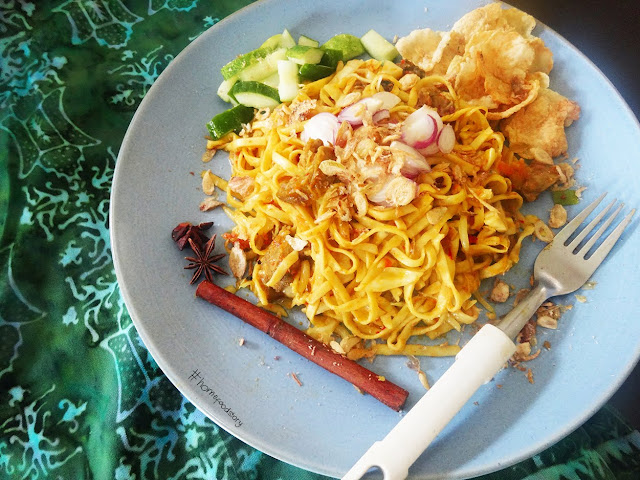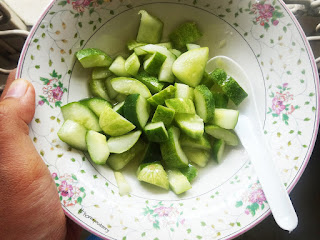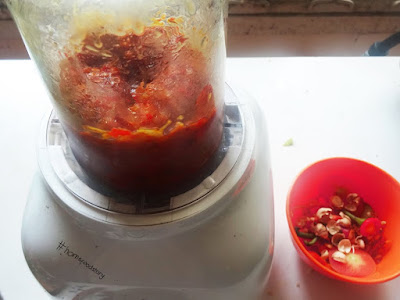
As I've mentioned above, spices used for this Mie Aceh were the same ones used in curry. How it finally be with noodle in somewhere far from India and China? During trading era a thousand year ago, Aceh was one of the transit place in main trading route from India and China. The curry spices, as you can suggested, was carried by the merchants from India. The noodle itself was the influence from Hokkian Chinese, presumably during the transmigration on 16 - 19th century.
And if you ever visited Malaysia and tasted their Mie Mamak, the noodle shape was alike with this Mie Aceh! It is because the same kind of noodle they used, Hokkian noodle, which is looked thicker than the usual noodle. Too bad I cannot find one when visiting the nearby supermarket.
This Mie Aceh was not so popular before 2004. Some seller stated it was because the tsunami in Aceh on late 2004 that made people curious about Aceh culture and its cuisine. It's kind of ironic, but there's always a blessing after the dark, isn't it?
The original Mie Aceh, beside mutton, goat, or beef, usually also has seafood in it, due to their geographic situation. The preference to used mutton or beef was believed to be the Arab's influence. Meanwhile, the Indonesian's influence can be found in emping.
Indian, China, Indonesia, and Arab's influences are found in one delicious plate; Mie Aceh is the perfect example to capture how diversity can work beautifully together.
About this recipe
I cannot find reliable recipe to be copied, so in the end I modified this recipe like almost in total, adding more kind of spices as some sources stated that the authentic Mie Aceh is containing more than 10 kind of seasonings. There are two versions of Mie Aceh, the fried and the soupy. I preferred to have the fried, so I reduced the water content from the recipe.
Mie Aceh
Yield: 8
Total time: 2 hours
Ingredients:
- 300 grams goat meat
- 2 bay leaves
- 2 stick lemongrass
- 500 grams noodles, cooked
- 1 1/2 cup water
- 3 tomato, diced
- 2 scallions, minced
- 2 cups bean sprouts
- 2 cups sliced cabbage\
- Salt, to taste (about 1 1/2 teaspoon)
- 4 tablespoons vegetable oil to saute
- Spices A
- 2 bulbs onion, sliced
- 16 cloves shallot, sliced
- 10 cloves garlic, sliced
- 3 chili pepper, sliced
- Seeds from 6 cardamom pods
- 2.5 cm turmeric, sliced
- 3 teaspoon fennel seeds
- 1 teaspoon cumin
-Spices B
- 1 teaspoon nutmeg powder
- 1 cinnamon stick
- 5 star anise
- 6 cloves
- 2 teaspoon grinded black pepper
- Complement
- Pickles: 2 cucumbers, set aside the moist part in the center, chopped. Add 2 tablespoon vinegar, 2 tablespoon sugar, and 1 teaspoon salt. Set aside.

- Emping
- Keffir lime
- Sliced fresh shallots
- Fried onion for garnish
Direction:
1. Boil goat meat with bay leaves and lemon grass until well done in medium high for 20 - 25 minutes. After the meat's done, chopped in medium size chunks. (Do not throw away the bay leaves and lemongrass, we'll use them later)
3. Saute spices A mixture in large pan with medium heat, add chopped meat along with the bay leaves and lemongrass. As the meat and the spices were already cooked, for this process, cook just until the spices mixed with meat well.
4. Add spices B, tomato, and scallions. Stir and cook until tomato turns soften.
5. Add cabbage and bean sprout, cook until the vegetables turns tender.
6. Add noodle and water. Cook until the water boiled and reduced in volume.
7. Serve with complements and sprinkles of keffir lime juice.
5. Add cabbage and bean sprout, cook until the vegetables turns tender.
6. Add noodle and water. Cook until the water boiled and reduced in volume.
7. Serve with complements and sprinkles of keffir lime juice.






No comments:
Post a Comment